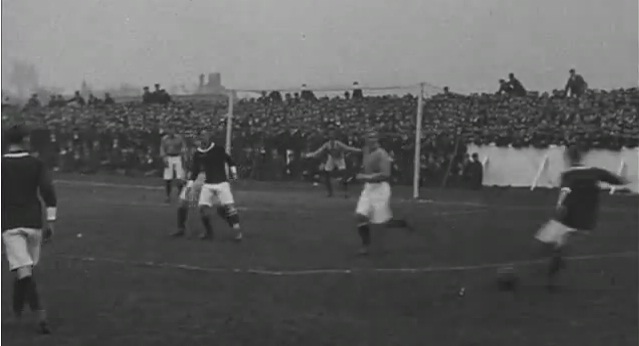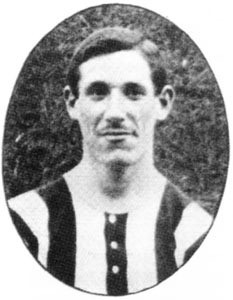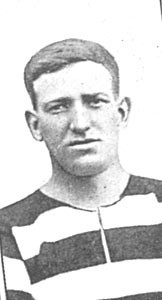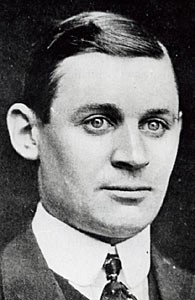CURIOUS FACTS ABOUT INTERNATIONAL AND NATIONAL PLAYERS (1906)
Picture : Wales against Ireland in Cardiff 1906
Interesting and curious facts about full internationals and national players (1906)
————————————————————————————————————–by IFFHS—
1906
James Conlin, born in Durham on July 6, 1881, played for Celt’s Rovers (Cambuslang), Hibernian (Edinburgh), Falkirk and Albion Rovers, from 1904 on also for the English clubs Bradford City, Manchester City (1906-1911) and Birmingham FC before he returned to Scotland in 1912 and joined Kilmarnock. He was a born footballer, a clever wing forward who assisted at and provided many goals. On April 7, 1906, he played his only match for England, which ended in a 1:2 defeat to Scotland in Glasgow. During World War I, the outside left served with the 15th Highland Light Infantry and fell in Flanders (Belgium) on June 23, 1917.
——
Outside right Alphonse Wright(born on 2.9.1887) of Racing Club de Bruxelles made his international début for Belgium in Paris on April 22, 1906. Neither the hosts nor the “Union Belge des Sociétés de Sports Athlétiques” (UBSSA) had realised that being English, he was not entitled to play for Belgium. Only two years later, after he had played for Belgium five times, did the Belgian FA discover that he only held British citizenship, and so no longer nominated him for the national team. Wright had kept this secret quite well.
Alphonse Wright Foto: IFFHS
——
The phrase “petit diables rouges” [little red devils] first appeared when the Belgian press celebrated the national team’s 5:0 victory over their Dutch rivals in Antwerp on April 29, 1906. This quickly became the national team’s epithet – “Diables Rouges”in French, “Rode Duivels” in Flemish. At first, the Belgian public only used the term at unofficial internationals, but a few years later, the whole world had come to apply it to the Belgian national team – to this day.
——
Valentin Harris, who was born on June 23, 1884, and played for Shelbourne FC (Dublin), made his international début for Ireland against England (0:5) at Solitude in Belfast on February 17, 1906. The inside forward played for Ireland 20 times until 1914. “Val” Harris also excelled at Gaelic football, winning the All Ireland Medal with Dublin in 1901. In many parts of Ireland, Gaelic football was and remains more popular than soccer.
——
Dr. Thomas Mayne Reid Waddell, a doctor of medicine, played for Cliftonville FC (Belfast), where he also was the captain from 1904 onwards. 1906 was a great year for him. The centre forward, who was very dangerous in front of goal, made his international début for Ireland in Dublin on March 17 (0:1 Scotland). During this year, he also received both his licence as a physician and his degree and went on to practise medicine as a surgeon in Glossop, where until 1908 he played several matches for the local second-division club. He became infected while operating on a child and died in Haydock Hospital (Glossop) on May 19, 1926, at the age of 44.
——
The CzechFA, which had been a provisory member of FIFA since 1906, became a full member one year later, and so was entitled to play official full “A” internationals. However, the two strongest Prague clubs – SK Slavia and AC Sparta – refused to release their players for the international début against Hungary (1:1) in Budapest on April 1, 1906, as both clubs were at odds with the “Český svaz footballový” (Czech FA). The Hungarian press took offence, and wrote that that the Czechs had a low opinion of Hungarian football. During this match, the brothers Vladimír and Bohumil Jelínek (both with FK Smíchov of Prague) played on the Czech right wing under the pseudonyms “Jelen” and “Milka”.
——
In 1906 the Hungarian FA hired Alfréd Hajós-Guttmannas the new national coach. Up until 1902, Hajós-Guttmann had played as inside forward, and captained Hungary at their international début in Vienna (0:5 Austria). The all-round sportsman, who was born on February 1, 1878, had won the Hungarian championship in 1901 and 1902 with Budapesti Torna-Club, and played until 1903. He had also been a prolific scorer. In 1896 he was the first Hungarian Olympic gold medalist (100 m freestyle swimming).
——
James S. Young, who was born in Kilmarnock on January 10, 1882, played for Dean Park FC before joining their great local rivals Kilmarnock FC. He later transferred to Barrow and Bristol Rovers, and in 1903 to Glasgow Celtic. His footballing career continued until 1917, when injury brought it to an end. While he was with the “Celts”, he won the Scottish Cup six times and the Scottish championship nine. Known to all as “Sunny Jim”, the right half-back and long-standing team captain fit and very consistent. “Sunny Jim” only played for Scotland once, though, in a 1:0 victory over Ireland in Dublin on March 17, 1906. He died in a motorcycle crash on September 4, 1922.
James “Sunny Jim” S.Young Foto: IFFHS
——
When Wales surprisingly beat Scotland 2:0 on March 3, 1906, the Welsh attack counted three Jones, none of whom were related. Outside right William Jones( .4.1882-13.7.1941), born in Chirk, was popularly only known as “Lot”. Inside left Richard Jones, born in Mongomeryshire in 1879, was just called “Dick” and was the brother of Edward and “Will” Jones, both of whom also played for Millwall. Centre forward John Jones, born in Rhyl in 1885, was only known as “Love” Jones. He played for Rhyl, Stoke (1905-1907), Crewe, Middlesbrough (1909-1911) and Portsmouth. “Love” still was playing football when he contracted tuberculosis, and five months later died in his native town on December 21, 1913, at the age of 28.
——
Héctor J. Henman, born in Oxford (England) on January 5, 1879, left for South Africa early on. He continued to play football there, and eventually was called up for the South African selection, with which he went on a tour of South America in 1906. Héctor Henman did not return to South Africa but stayed in Argentina, where he joined Buenos Aires top club Alumni AC. On October 21, 1906, the inside forward made his international début with Argentina (2:1 Uruguay in Buenos Aires). This match also featured outside left Wilfredo A. Stocksof Belgrano AC, who had been born in Nottingham on April 5, 1883, and come to Argentina with his parents as a child. The former Argentine international died in 1977 at the age of 94.
——
Joseph William Henry Makepeace, born in Middlesbrough on August 22, 1881, started playing football at the Liverpool School, also for the Liverpool Juniors. In 1903 he joined Everton FC for good. He was a fairly attacking left wing half-back, and from 1906 to 1912 played for England four times. In 1906 he won the English Cup with the “Toffeemen”, reached the English Cup final in 1907, and won the English championship in 1915. “Harry” Makepeace also was an all-rounder. He was a first-rate cricketer, and played cricket for Lancashire from 1906 to 1930, scoring 25,745 runs, and also played cricket for England. He later worked as a cricket coach and died on December 19, 1952.
——
Edward Gordon Dudas Wright, born in Earlsfield Green (Surrey) on October 3, 1884, attended St. Lawrence School, Queen’s College (Cambridge) and the Royal School of Mines. While playing for Cambridge University, he also played once for England (1:0 Wales) on March 19, 1906. After his studies, he played for Worthing, Reigate Priory, Leyton, Portsmouth and Hull City, and at the same time also for Corinthians (London). From 1908 to 1912 he played 15 official full “A” internationals for the England amateurs, scored five goals and was part of the side which won the 1912 Olympic football tournament. “Ted” Wright became a professor at Hymer College (Hull), but in 1913 went to South Africa as a mining engineer, where after a short stay in the USA he died in June 1947 at the age of 62.
——
Samuel Hulme Day, born in Peckham on December 29, 1878, attended Malvern College and Queen’s College (Cambridge), where he also practised sports. After his studies he became a teacher, played for Old Malvernians (London) and taught at Westminster School. In 1906 the inside right played for England three times and scored two goals. When the England amateurs played France (15:0) in Paris in 1906, he also scored two goals. At the same time, he also played for Corinthians (London) both during his studies and afterwards until 1912. “Sammy” Day also was an outstanding cricketer, playing for Kent from 1897 to 1919, where he scored 7,722 runs at the highest level.
Samuel “Sammy” Hulme Day Foto: IFFHS
——
The great and famous school clubs in England had founded their own Amateur Football Association(AFA) which was neither affiliated nor subordinated to the Football Association (FA). This AFA also fielded a selected team which played against a French select XI from national French associations which were likewise not affiliated with FIFA and, like the AFA, not entitled to play official full “A” internationals. Samuel Hulme Day also played several matches for the AFA, including an 8:0 win over a USFSA team in Paris on March 18, 1909, and a return match in Ipswich on March 12, 1910, which his side won 20:0. “Sammy” Day scored five goals during the former match, and 11 (!) during the latter. Since neither the AFA nor the USFSA were affiliated to FIFA, his goals cannot be considered a world record. The forward with the Master of Arts degree died on February 20, 1950.
——
Up until World War I, the French national team had played 36 official full “A” internationals. The following 17 French internationals fell during World War I: Marius Royet (Union Sportive Parisienne), Henry Gigot (Club Français Paris), André François (Racing Club de Roubaix), André Puget (Racing Club de Paris), Albert Jenicot (Racing Club de Roubaix), René Fenouillère (Red Star Amical Club de Paris), Pol G. Morel (Red Star Amical Club de Paris), Francis Vial (Club Athletique de Vitry), Charles Dujardin (Union Sportive Tourquennoise), Émile Dusart (Racing Club de Roubaix), René Camrad (Association Sportive Franais Paris), Julien Denis (Racing Club de Calais), Charles Geronimi (AF Garenne Colombes Paris), Ernest Guéguen (Union Sportive Servannaise et Malouine Saint-Malo), Jean Loubière (Gallia Club de Paris), Pierre Six (Olympique Lillois), J. Verbrugge (Association Sportive Française Paris). Club affiliations were determined at the time of a player’s international début. French national goalkeeper Zacharie Baton (Olympique Lilloise), who played for France four times from 1904 to 1906, lost a leg in 1915 while fighting in World War I.
——
Jonkheer Constant Willem Feith, who was of royal lineage, was born on August 3, 1884. He studied law and became a judge. He also was a talented sportsman, played in the Dutch national cricket team and on April 29, 1906, made his international début with the Dutch national football team in Antwerp (0:5 Belgium). He played for HVV (The Hague), the most successful Dutch club during the first decade of the 20th century. Although his technical means were limited, the inside forward had a keen sense for goals. During a Cup match in 1904, when HVV beat Bussumsche FC 20:0, he alone scored ten goals. During the 1906/07 season he played 29 matches and scored 53 goals. In 1908 the physically robust “Wim” Feith switched to defence. On September 26, 1920, he played his 350th (in total) and last match for HVV. During his career he scored a total of 234 goals, even though he had been a defender for the past 12 years. “Wim Herr von” Feith died on September 15, 1958.



